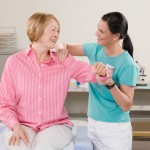
One of our older Elf friends is waiting for surgery to repair a torn tendon in the rotator cuff muscle group. We know that post operative management of rotator cuff (RC) tears has to balance, minimising stress on the repair with preventing stiffness and weakness, caused by reduced movement after surgery.
While trying to find the best evidence based management for our friend, our Elves came across this article that asked whether early or delayed active range of movement (ROM) adversely affected healing.
Here’s what they did
Pubmed, Embase and the Cochrane database were searched between January 2004 and April 2014 for studies in this area. Inclusion criteria were: full thickness rotator cuff tears; tendon(s) treated by primary repair; description of the size of tear intraoperatively; description of time to initiation of active ROM; RC healing assessed at least one year post-operatively with MRI, ultrasound, arthrogram or a combination of these techniques; and sufficient data regarding ROM initiation. They excluded subscapularis or partial thickness tears; patients undergoing tendon revision, reconstruction, arthoplasty or tendon transfer; and lack of sufficient data.
Surgical approach was categorised as open, mini-open or arthroscopic. Repair methods were categorised as transosseous (TO), single row suture anchor (SA), double row suture anchor (DA), or double row suture bridge (SB). Tear size was presented in the studies in either 4 categories: >1cm, 1-3 cm, 3-5 cm, and >5cm; or two categories: less than or equal to 3 and greater than 3cm. Integrity was categorised as intact (completely plus partially healed tears) or retorn.
Here’s what they found
From 4633 articles, 37 papers describing a total of 2251 RC repairs met the inclusion criteria and were included in meta-analysis. There were ten papers (n=649 RC repairs) in the early group, and 27 (n= 1602) in the delayed ROM group.
Most tears were SA repairs and measured three cm or less. Active ROM was started in the early group less than six weeks post operation, and six weeks or more in the delayed group.
- In tears one cm or less: there were no statistically significant difference in re-tear rates between early versus delayed groups for TO, SA or DA repairs. There were no SB repairs in this group.
- One to three cm: there were no statistically significant difference in re-tear rates between early versus delayed groups for any repair method.
- Three cm or less: the risk of re-tear was higher in the early versus delayed groups for TO and SA repairs (37% vs 24.3%; RR, 1.63 [95% CI, 1.28-2.08]).
- Three to five cm: there were no statistically significant difference in re-tear rates between early versus delayed groups for any repair method.
- Three cm or more: the risk of re-tear was higher in the early versus delayed groups for SB repairs (48% vs 17.5%: RR, 2.74 [95% CI, 1.59-4.73]) and all repair methods combined (40.5% vs 26.7%; RR, 1.52 [95% CI, 1.17-1.97]). There were no statistically significant difference in re-tear rates for TO and SA repairs or DA repairs.
- Five cm or more: risk of re-tear was higher in the early versus delayed groups for SB repairs (100% vs 16.7%; RR 6.00 [95% CI, 1.69-21.26]). There were no statistically significant difference in re-tear rates for TO and SA repairs, DA or all repair methods combined.
The authors concluded
Early active ROM may be harmful to the healing process for small and large repairs regardless of repair method. Delaying active ROM by at least six weeks after RC repair may be advisable.

Early active range of movement may be harmful to the healing process for small and large repairs. Waiting at least 6 weeks is advised!
The Musculoskeletal Elf’s view

This interesting review has suggested early mobilisation can increase the risk of re-tear depending on tear size and type of repair. It would seem sensible to consider these variables within individual post-operative treatment plans, particularly when deciding the best time to start active range of movements.
Our Elf friend is waiting to find out what type of repair he needs, we’ll be keeping a watchful eye on him!
What do you think?
- What post-operative advice do you give to patients regarding the timing of active range of movement exercise?
- How do these findings relate to your experience in practice?
Send us your views on this blog and become part of the ever expanding Musculoskeletal Elf community. Post your comment below, or get in touch via social media (Facebook, Twitter, LinkedIn, Google+).
Links
Kluczynski, M. A., Isenburg, M. M., Marzo, J. M., & Bisson, L. J. (2015). Does Early Versus Delayed Active Range of Motion Affect Rotator Cuff Healing After Surgical Repair? A Systematic Review and Meta-analysis. The American journal of sports medicine, [Abstract]

Healing post rotator cuff repair – early versus delayed active movement http://t.co/kIq1SUWxWB
Was there any mention at all about passive ROM regimes?
Hi there, the article was looking specifically at active ROM, earlier in the introduction it states “Current concepts advocate commencement of active ROM exercise after an adequate period of passive ROM” with reference to a guideline published by van der Meijden et al 2012.
Healing post rotator cuff repair – early versus delayed active movement | The MSK Elf blog http://t.co/YOI23fpegI
I think the question here is – are all partial tears or even full thickness/ full width tears always symptomatic and therefore is repairing them necessary in the first place.